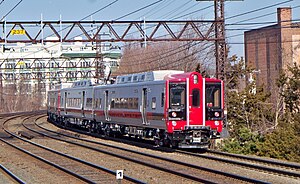M8 (railcar)
| M8 | |
|---|---|

Metro-North M8 train at Port Chester, NY along the New Haven Line
|
|
| In service | March 2011-present |
| Manufacturer | Kawasaki Heavy Industries |
| Family name | M-Series |
| Number built | 405 (in use) 60 additional planned (with 34 more if an option order is exercised) |
| Formation | 190 Married pairs, 25 Singles |
| Capacity | Seated passengers: 111 (A car); 101 (B car) 114 (Single car) |
| Operator(s) |
Metro-North Railroad Connecticut Department of Transportation |
| Specifications | |
| Car length | 85 ft 0 in (25,908 mm) |
| Width | 10 ft 6 in (3,200 mm) |
| Maximum speed | 100 mph (161 km/h) (Design) 80 mph (129 km/h) (Service) |
| Weight | 144,850 pounds (65,700 kg) (A car) 143,780 pounds (65,220 kg) (B car) 97,659 pounds (44,297 kg) (Single car) |
| Transmission | Mitsubishi Electric AC Traction Motors |
| Power supply | Third rail, Catenary |
| Electric system(s) | 750 V DC (Third rail) 12.5 kV 60 Hz AC (Catenary) 25 kV 60 Hz AC (Catenary) |
| Current collection method |
Contact shoe Pantograph |
| Braking system(s) | Regenerative / Pneumatic |
| Coupling system | Budd Pin and Cup coupler |
| Track gauge | 4 ft 8 1⁄2 in (1,435 mm) |
The M8 is an electric multiple unit railroad car built by for use on the New Haven Line of the Metro-North Railroad. It replaced the fleet of 244 M2s which entered service in 1973-1974, as well as 54 M4s and 48 M6s which entered service in 1987-1988 and 1994 respectively.
The M8 is similar in design to the M7 car used on the Harlem Line and the Hudson Line. Like the M7, the M8 is able to pick up 750 Volt DC direct current power from underruning third rail for operation along the New Haven Line from Grand Central Terminal to Pelham, where the traction power source is transferred to the overhead catenary wire. The overhead wire is at a nominal 12.5 kV AC power from overhead lines via pantographs for operation from Pelham, New York to New Haven, Connecticut (as well as along the New Canaan Branch), and 25 kV AC power from catenary for operation along the Shore Line East route east of New Haven to New London, Conn. Unlike in earlier classes, changeover between the two AC voltages can be made by the engineer while on the move.
In response to rising number of people seeking to use their bicycle to solve the "last mile" problem between Metro-North stations and destinations, ConnDOT has pledged to provide bike racks for storage of two bicycles in the disabled riders area of each rail car. In the event that a disabled rider boards a car, all cyclists must move their bicycles to the entry vestibule. In spite of the hook installation, during peak travel periods only folding bicycles are permitted aboard most Metro North trains.
...
Wikipedia
